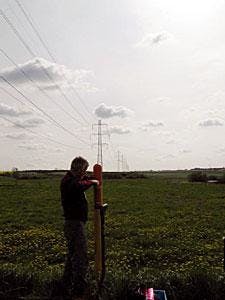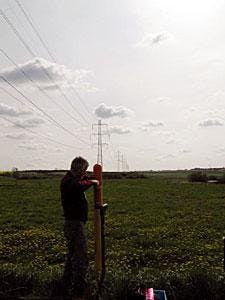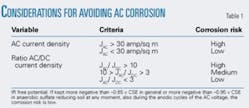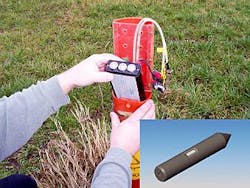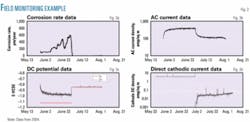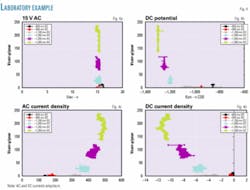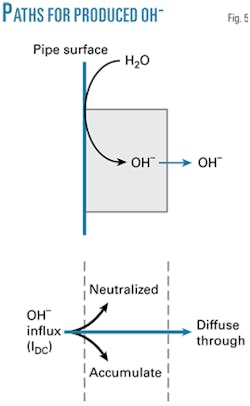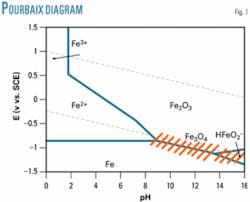European field monitoring programs and subsequent laboratory investigations have shown that excessive cathodic protection (CP), combined with induced AC, enhances the risk of corrosion. Increasing the CP level is therefore not advisable as a countermeasure to corrosion for pipelines with AC.
Updates of European guidelines and standards are now in progress, and the National Association of Corrosion Engineers (NACE) has formed a task group (TG 327), whose ultimate goal is to develop a recommended practice on AC corrosion control. The immediate goal of the group is to produce a state-of-the-art report on the subject.
Often pipelines have paralleled high-voltage overhead electric power transmission lines or AC-traction railways, which induce AC voltage on pipelines (Fig.1). For personnel safety, the level of induced AC should not exceed a certain level, typically 50-60 v. Methods have been developed and standardized for the mitigation of such AC voltages, e.g., the installation of AC discharge devices and relevant low-resistance earth electrodes.1 2
Although industry has known about the personnel hazard issue for many years, only recently have reports emerged on the increased risk of corrosion due to AC voltage.3-6 High penetration rates (more than 10 mm/year) are sometimes seen despite properly imposed CP. A low enough pipe-to-soil resistance at a specific current path created through a coating defect can produce AC current densities from several hundred to 1,000 amp/sq m at tiny coating defects.
One recommendation for decreasing the risk of corrosion caused by stray DC currents is to apply a surplus of CP (NACE RP0169). This strategy may also mitigate the risk of AC-influenced corrosion.7
Field monitoring of instant corrosion rates on pipe-connected coupons with small artificial coating defects, however, has shown that AC-influenced corrosion increases in penetration rate when the CP dose increases. On the other hand, when decreasing and minimizing the CP dose (close to -850 mv copper sulfate electrode [CSE] off-potential), the AC-influenced corrosion becomes dramatically smaller or disappears altogether.
Path to a standard
The newly formed TG 327 has the ultimate goal of developing a recommended practice on AC corrosion control and the immediate goal of producing a state-of-the-art report.
The European standard covering CP requirements for buried structures (EN 12954, appendent to NACE RP 0169) is also inadequate in dealing with the AC problem.8
An update to the general management of cathodic protection described in standard EN 12954 has therefore been prepared that provides a set of guidelines on how to mitigate and monitor AC-induced corrosion.9
It suggests a limit for the AC voltage so as not to exceed 10 v for the entire pipeline and 4 v where the local soil resistivity is less than 25 ohm/sq m. These values should significantly reduce the risk of AC corrosion but are insufficient nevertheless for avoiding possible AC corrosion altogether.
Further considerations are necessary, including criteria (Table 1) from measurements on small area coupons (1 sq cm coating fault).
Additionally, the DC potential should be adjusted as close as possible to, but more negative than, the usual criteria given by EN 12954 (mild, not excessive, CP). The literature discusses the consensus criteria.10
Automated coupon data-logging device
Pipe-connected coupons buried at desired depth in the soil for measuring the previously mentioned electrical parameters would seem to be a tool for evaluating and monitoring the corrosion risk in AC-infected pipelines. The electric parameters, however, indicate nothing specifically about the corrosion rate. This has led to the development of a method in which the coupon is part of an electrical-resistance (ER) sensor.11-14
A time-stamped instant rate of corrosion can be correlated with the electrical parameters on the coupon by allowing an automated coupon data-logging device (ACD) to continuously pick up electrical data as well as ER data. The instrumentation is positioned in standard measuring posts along the pipeline (Fig. 2).
The shape and size of the artificial coating defect that should be represented by the coupon is an important parameter. The spread resistance, or ohmic coupon-to-earth resistance, is a function of both the resistivity of the soil immediately near to the coating fault and the size and shape of the fault. Smaller coating faults seem to be more prone to AC corrosion due to the lower spread resistance of such small defects.
The design of the ACD includes options for setting up a preprogrammed time schedule for the instrument to perform a series of measurements on the coupons.11
Initially the current flowing between the pipe and the individual coupon is measured. One coupon at a time is then disconnected from the pipe and the AC voltage between the pipe and the coupon is measured. Finally, the instrumentation measures the resistance of the elements of the ER coupon.
All data are saved in a built-in data logging facility or transferred to a control center. A data treatment procedure results in graphical presentations.
Field monitoring
Fig. 3 shows examples of graphics the ACD generated. This case describes the AC-corrosion characteristics as they evolved during roughly 1 month. The corrosion rate increased steadily and reached 600 μm/year (Fig. 3a).
The rectifier on-potential was adjusted to -1.15 v CSE in this period (Fig. 3c), until the corrosion rate reached its peak. The rectifier potential was then adjusted to -0.85 v and the cathodic DC current density immediately dropped to 0.035 amp/sq m from a rather high 3.5 amp/sq m. Corrosion immediately stopped at this time.
The pipeline AC voltage was constant near 15 v for the entire period. Fig. 3b shows that the AC current density increased with corrosion up to about 400 amp/sq m. Despite no reduction in AC voltage, the AC current density decreased to around 100 amp/sq m when the rectifier potential was adjusted. This indicated that the rectifier potential (or rather the DC current density) had a tremendous effect on the AC current density.
In all cases where this concept has identified AC-influenced corrosion, the same pattern has occurred.
Laboratory experiments
A wide range of laboratory experiments on soil-box environments have helped researchers study the mechanisms of AC-influenced corrosion, some of which have previously been published.15-18
The experimental procedures are practically the same for laboratory and field applications. A coupon is placed in the environment of interest to simulate a coating fault. In the laboratory, the environment is typically a soil-box filled with inert quartz sand and enriched with pore water of known composition.
The coupon is connected to a rectifier-transformer system, which-via a large inert counter electrode and a reference-produces the desired AC-DC pattern on the coupon. The data logger assembly collects AC voltage, currents, spread resistance, etc. The coupon is attached to an ER probe to enable measurement of corrosion rates.
Fig. 4 shows the results from a series of experiments performed in inert quartz sand plus a 0.005-molar NaOH solution. Six 3-week experiments were run and the electrical parameters and corrosion rates were recorded. The experiments differed by the applied DC on potential (-850, -950, -1,100, -1,200, -1,250, and -1,300 mv CSE). In all experiments the AC voltage was adjusted to 15 v.
Fig. 4a illustrates the dependency of the corrosion rate on AC voltage, which is practically absent because corrosion can result from increasing the CP level (Fig. 4b and Fig. 4d). Fig. 4c shows that the AC current density at constant AC voltage depends on the DC conditions. A high AC current density is produced at higher levels of CP; at lower CP levels the AC level is also lower. The results from field monitoring and those produced in laboratory soil boxes were consistent.
Mechanistic considerations
Alkalization of the environment near a coating fault seems to be a key factor in the mechanism of AC-influenced corrosion. The alkalization arises from the cathodic protection current, which electrochemically reduces water into hydroxyl ions, OH-:
2H2O + 2e-→ H2 + 2OH- (1)
One can set up a mass balance in a volume element at the coating fault (Fig. 5). The CP current density determines the influx of OH-. The buffer effect of the chemistry of the close environment determines the neutralization of the produced OH-; the outflux of OH- results from outward diffusion away from the coating defect area into the bulk.
This mass balance determines whether OH- accumulates and therefore the extent of the pH increase at the surface. An incubation period before corrosion initiates is typical and corresponds to the time needed to create a critically high pH, of about 12-14.
Fig. 6 shows the correlation between DC and AC current density. The DC current density produces the alkalinity, which modifies the environment in the vicinity of the coating defect and lowers the spread resistance due to the increased concentration of ionic charge.
The decreased spread resistance increases the AC current density, even at constant AC voltage, because this is determined simply through Ohm’s law (AC voltage divided by the spread resistance). The decreased spread resistance may also impose increased DC current density at constant on-potential.
Fig. 7 illustrates in the Pourbaix diagram the critical area for AC corrosion. High pH combined with an oscillation of the DC potential caused by the AC may cause corrosion either by a destabilization of the passive layer or, in the case of extreme alkalization, by entering the general corrosion area (HFeO2- stabilization) at high pH.
Salts (carbonates, hydroxides) of Ca2+ and Mg2+ are rather insoluble, and would form at the surface when alkalinity occurs. Presence of these ions is therefore reported to increase the spread resistance and decrease the likelihood of AC corrosion. Originally, Stalder presented the alkalization theory.19
One consequence of the alkalization mechanism is that excessive cathodic protection would be expected to increase rather than decrease the AC corrosion risk. This has been shown through both laboratory and field monitoring programs.
The first mitigation measure is to bring down the AC by proper groundings (or by sectioning the pipe), for instance via solid-state polarization cells. Currently, these cells are available with intelligent self-disconnecting capabilities that eliminate capacitive decays when performing measurements of the instant off pipe potentials.2 16
The second step is to control the DC level carefully. One should take care not to confuse this with the recommendations given in the EN update, especially the JAC/JDC criterion, which may apply only when the criterion of mild (not excessive) CP has been followed. The criterion relating to the IR free potential (which should be more negative at any moment than a certain value) may be in direct conflict with the mild CP criterion.
The recommendation here is to use (ER) coupons as tools for assessing the corrosion risks. The real challenge exists in the borderline between mitigation against DC stray current corrosion (which often involves applying a surplus of cathodic protection current), and AC-influenced corrosion, which has the opposite requirement. ✦
References
1. “Mitigation of Alternating Current and Lightning Effects on Metallic Structures and Corrosion Control Systems,” NACE-RP0177-2000, NACE International, Houston, 2000.
2. Rosenberg, H., “AC Mitigation with Intelligent Switch Devices,” CeoCor 2003, Brussels.
3. Movley, C., “Pipeline Corrosion from Induced AC-Two UK Case Histories,” NACE Corrosion 2005, Houston, 2005.
4. Floyd, R., “Testing and Mitigation of AC corrosion on 8’’ line: A Field Study,” NACE Corrosion 2004, Houston.
5. Hanson, H.R., and Smart, J., “AC Corrosion in a Pipeline Located in a HVAC Utility Corridor,” NACE Corrosion 2004, Houston.
6. Wakelin, R., and Sheldon, C., “Investigation and Mitigation of AC corrosion on a 300 mm Diameter Natural Gas Pipeline,” NACE Corrosion 2004, Houston.
7. “Control of External Corrosion on Underground or Submerged Metallic Piping Systems,” NACE RP0169-2002, NACE International, Houston, 2002.
8. “Cathodic Protection of Buried or Immersed Metallic Structures - General Principles and Application for Pipelines,” EN 12954-2001, CEN - Brussels, 2001.
9. Technical Specification - Corrigendum to EN 12954, “AC Corrosion of Buried Metallic Pipelines,” 9th draft, July 27, 2004, TC 219 - WG 1 - Ad Hoc Group 4, CEN, Brussels, 2004.
10. Schöneich, H.G., “Discussion of Criteria to Assess the Alternating Current Corrosion Risk of Cathodically Protected Pipelines,” Proc. CeoCor Sector A, Dresden meeting, CeoCor, Brussels, 2004.
11. Nielsen, L.V., and Galsgaard, F., “Sensor Technology for On-Line Monitoring of AC Induced Corrosion Along Pipelines,” NACE Corrosion 2005, Houston.
12. Nielsen, L.V., and Nielsen, K.V., “Differential ER-technology for Measuring Degree of Accumulated Corrosion as well as Instant Corrosion Rate,” NACE Corrosion 2003, Houston.
13. International patent application, PCT/DK00/00689.
14. “A method and a system of diagnosing corrosion risk of a pipe or a pipeline in soil,” European patent application 04388014.5.
15. Nielsen, L.V., “Role of Alkalization in AC Induced Corrosion of Pipelines and Consequences hereof in Relation to CP Requirements,” NACE Corrosion 2005, Houston.
16. Nielsen, L.V., et al., “AC Induced Corrosion in Pipelines: Detection, Characterization, and Mitigation,” Paper No. 04211, NACE Corrosion 2004, New Orleans.
17. Nielsen, L.V., Baumgarten, B., and Cohn, P., “On Site Measurements of AC induced Corrosion: Effect of AC and DC Parameters,” CeoCor Sector A, Dresden meeting, CeoCor, Brussels, 2004.
18. Nielsen, L.V., Baumgarten, B., and Cohn, P., “Investigating AC and DC Stray Current Corrosion,” CeoCor Sector A, Malmö meeting, CeoCor, Brussels, 2005.
19. Stalder, F., et al., “AC corrosion on cathodically protected pipelines,” 5th International Congress CeoCor, Brussels, 2000.
The author
Lars Vendelbo Nielsen is founder and president of MetriCorr ApS, Copenhagen. He has previously worked as a freelance consultant in corrosion research and monitoring. Nielsen holds a PhD in cathodic protection and industrial corrosion monitoring from the Technical University of Denmark in Copenhagen (1995).
